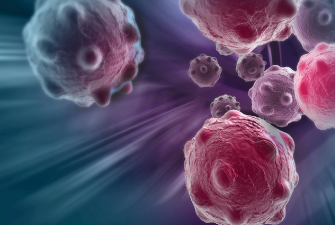Phase 1 Clinical Trial of Radioligand Therapy Shows High Ratios for Absorbed Dose
 Blue Earth Therapeutics today announced further promising developments for its radiohybrid lutetium labelled, PSMA targeted, investigational radioligand therapy. Radiation dosimetry and pharmacokinetic data from the 13 metastatic castrate resistant prostate cancer patients enrolled in the Phase 1 portion of a Phase 1/2 clinical trial (NCT05413850) of Lutetium (177Lu) rhPSMA-10.1 Injection showed proportionately higher absorbed radiation doses in tumors than in critical healthy tissues such as the kidneys. The data compares favorably to published data on first-generation PSMA-targeted radioligand therapies.
Blue Earth Therapeutics today announced further promising developments for its radiohybrid lutetium labelled, PSMA targeted, investigational radioligand therapy. Radiation dosimetry and pharmacokinetic data from the 13 metastatic castrate resistant prostate cancer patients enrolled in the Phase 1 portion of a Phase 1/2 clinical trial (NCT05413850) of Lutetium (177Lu) rhPSMA-10.1 Injection showed proportionately higher absorbed radiation doses in tumors than in critical healthy tissues such as the kidneys. The data compares favorably to published data on first-generation PSMA-targeted radioligand therapies.
The Phase 1 data shows that Lutetium (177Lu) rhPSMA-10.1 Injection has high ratios for absorbed radiation dose to tumors vs. dose to healthy tissues, with a measured mean tumor to salivary gland ratio of 73 and tumor to kidney ratio of 32. Median absorbed radiation dose to tumors defined by SPECT imaging was
8.9 Gy for each GBq of administered radioactivity. Mean absorbed radiation dose to the kidneys was 0.27 Gy/GBq; to salivary glands, 0.13Gy/GBq.
Underlying these results, the mean biological half-life in tumors for the Lutetium (177Lu) rhPSMA-10.1 Injection was 338 hours. When paired with the 6.7-day physical half-life of177Lu, this gives an effective mean half-life of 91.4 hours. This allows delivery of radiation to tumors over many days: one and a half to twice the reported data for established agents in this class1. This prolonged retention of the drug in tumors without proportionate increases to retention in normal tissues helps to explain the positive radiation dosimetry data.
Following recent consultation with regulatory authorities, and sharing of the preliminary data, this now opens the way for the Phase 2 portion of the Phase 1/2 trial to test innovative dosing regimens, with the goal of optimizing outcomes for patients. This Phase 2 portion of the study will explore the following dosing concepts:
- Administration of significantly higher overall injected radioactivity in comparison to recent Phase 3 clinical trials of other PSMA-targeted radioligand therapies
- Front loading of administered radioactivity in early cycles; and
- Extending the duration of administration of radioactivity beyond 36 weeks to provide longer time on treatment.
In combination with the promising Phase 1 data for Lutetium (177Lu) rhPSMA-10.1 Injection, these design factors should further support the aim of maximizing treatment response and therefore may enable delivery of better outcomes for patients. The Phase 2 portion of the study is expected to start this quarter.
David Gauden, DPhil, CEO of Blue Earth Therapeutics said, "The Phase 1 data provides strong validation of the innovative approach taken on optimizing radioligand therapy by Blue Earth Therapeutics and the inventors of the rhPSMA technology. The relative ratios of tumor to healthy organ absorbed radiation doses are key metrics in establishing a better profile of the risks and potential benefits of radioligand therapies. With radioligand therapies, normal organ toxicity considerations gate the total amount of radioactivity that can be administered, so the more of the radioactivity that accumulates in tumors, the better. Our goal is to substantially increase the potential for prostate cancer patients to benefit compared to available radioligand therapy, and completion of this study moves us closer to making that goal a reality."